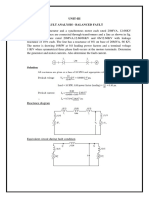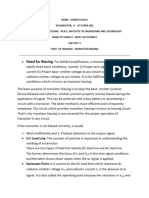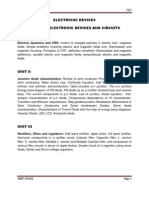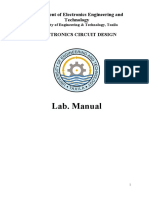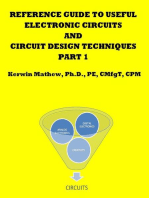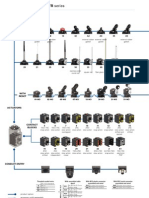Unit I: Power Supplies and Biasing of Discrete BJT and Mosfet
Unit I: Power Supplies and Biasing of Discrete BJT and Mosfet
Uploaded by
AlwynCopyright:
Available Formats
Unit I: Power Supplies and Biasing of Discrete BJT and Mosfet
Unit I: Power Supplies and Biasing of Discrete BJT and Mosfet
Uploaded by
AlwynOriginal Description:
Original Title
Copyright
Available Formats
Share this document
Did you find this document useful?
Is this content inappropriate?
Copyright:
Available Formats
Unit I: Power Supplies and Biasing of Discrete BJT and Mosfet
Unit I: Power Supplies and Biasing of Discrete BJT and Mosfet
Uploaded by
AlwynCopyright:
Available Formats
EC6304 – Electronic Circuits I Unit -1
Unit I
POWER SUPPLIES AND BIASING OF DISCRETE BJT AND MOSFET
1. What is an amplifier?
An amplifier is a device which produces a large electrical output of similar
characteristics to that of the input parameters.
2. What are transistors?
Transistor is three terminal devices that can function as electronic switches or
as signal amplifiers. They are current operated devices with high input impedance and
low output impedance. Since it transfers current from a high to a low resistance
region, it was named bipolar.
3. What is Biasing? And need for biasing.[NOV/DEC-08,11],[MAY/JUN-09,13]
Biasing In order to operate transistor in the desired region we have to apply external
dc voltages of correct polarity and magnitude at the two junctions of the transistor.
Need for Biasing: From the above discussion, it is clear that we have to supply
external d.c. voltages (d.c. biasing) of correct polarity and magnitude to the two
junction of the transistor, to operate in the desired region.
In transistor circuits, output signal power is always greater than input signal power.
Now the question is how this amplification of power is achieved. The d.c. sources(d.c.
biasing) supplies the power to the transistor circuit to get the output signal power
greater than input signal power.
4. What are the requirements for biasing circuits?
a. The Q point must be taken at the Centre of the active region of the output
characteristics.
b. Stabilize the collector current against the temperature variations.
c. Make the Q point independent of the transistor parameters.
d. When the transistor is replaced, it must be of same type.
e. Emitter diode should be forward bias and collector diode should be reverse
biased.
f. There should be a zero signal collector current.
5. Explain about the characteristics of a transistor?
Input characteristics: it is drawn between input voltage & input current while
keeping output voltage as constant.
Output characteristics: It is drawn between the output voltage &output current
while keeping input current as constant.
6. What is operating point?
For the proper operation of the transistor a fixed level of current and voltages
are required. This values of currents and voltages defined at a point at which the
transistor operate is called operating point.
7. What is D.C load line? [NOV/DEC-06][MAY/JUN-12]
The d.c load line is defined as a line on the output characteristics of the
transistor which gives the value of Ic & Vce corresponding to zero signal condition
Kamaraj College of Engineering and Technology Page 1
EC6304 – Electronic Circuits I Unit -1
8. Why do we choose q point at the center of the loadline?
The operating point of a transistor is kept fixed usually at the center of the
active region in order that the input signal is well amplified. If the point is fixed in the
saturation region or the cut off region the positive and negative half cycle gets clipped
off respectively.
9. Name the two techniques used in the stability of the Q point .explain.
Stabilization technique: This refers to the use of resistive biasing circuit
which allows IB to vary so as to keep IC relatively constant with variations in
Ico,β,&VBE.
Compensation techniques: This refers to the use of temperature sensitive
devices such as thermostats diodes. They provide compensating voltages ¤ts to
maintain operating point constant.
10. Define stability factor?[MAY/JUNE-09,10][ NOV/DEC-09,12]
Stability factor is defined as the rate of change of collector current with
respect to the rate of change of reverse saturation current.
11. What are the basic relationships of BJT transistor?
12. What are the basic rules of an operating amplifier?
The operating point should be fixed on the load line. The upper end of the
load line lies on the saturation region &lower end lies on the cutoff region.
13. What are the methods for biasing? [MAY/JUNE-09,10][ NOV/DEC-09,12]
The transistor needs two bias voltages VBB and VCC. The VBB supply is used
for biasing of the emitter junction and VCC supply for biasing the collector base
junction. Also it is possible to bias both the junctions using a single supply.
Common Methods :
1. Fixed Bias or Base Bias.
2.Collector feedback bias
3. Voltage divider bias or Emitter bias or self bias
14. What are the disadvantages of collector to base bias?
a. The collector current is high.
b. If AC signal voltage gain feedback into the resistor Re , it will reduce the gain
of the amplifier.
15. Why is the operating point selected at the Centre of the active region?
[NOV/DEC 07]
The operating point is selected at the Centre of the active region to get to
perfect amplification. Moreover there is no distortion.
Kamaraj College of Engineering and Technology Page 2
EC6304 – Electronic Circuits I Unit -1
16. Give the expression for stability factor.[MAY-07,08]
S= (1+β)/[(1-β)(δ IB/δ IC)]
17. Define the stability factors S’ and S’’. [MAY-07,08]
The stability factor S’ is defined as the rate of change of IC with VBE, keeping
β & IC0 constant
The stability factor S” is defined as the rate of change of IC w ith β, keeping VBE&
IC0 constant.
18. What are the advantages of fixed bias circuit?
i. This is simple circuit which uses a few components. The operating point can be
fixed anywhere on the Centre of the active region.
j. The β value is high, stability factor is very large. so the operating point does not
maintain by properly.
19. What are the advantages of self bias circuit?
The stability factor value is very very small compare than other biasing circuit.
This biasing should maintain an operating point
20. Give the stability factor S for the fixed bias circuit.
The stability factor for the fixed bias circuits is
β = current gain of the transistor
21. What do you meant by thermal runway?[NOV/DEC-06]
Due to the self heating at the collector junction, the collector current rises.
This causes damage to the device. This phenomenon is called thermal runway.
22. What t is heat sink?
A heat sink is an environment or object that absorbs and dissipates heat from
another object using thermal contact (either direct or radiant). Heat sinks are used in a
wide range of applications wherever efficient heat dissipation is required; major
examples include refrigeration, heat engines and cooling electronic devices.
23. What is biasing of FET ?
Like BJT, the parameters of FET are also temperature dependent. In FET, as
temperature increases drain resistance also increases, reducing the drain current. Thus
reducing the possibility of thermal runway.
Kamaraj College of Engineering and Technology Page 3
EC6304 – Electronic Circuits I Unit -1
24. How FET is known as voltage variable resistor?[DEC-06]
In the region before pinch off, where VDS is small the drain to source
resistance rd can be controlled by the bias voltage VGS. Therefore FET is useful as a
voltage variable (VVR) or voltage dependent resistor (VDR).
25. Why the input impedance of FET is more than that of a BJT?
The input impedance of FET as more than that of BJT because the input
circuit of FET is reversed biased where as the input circuit BJT is forward biased.
26. What are the methods of bias compensation technique?
1. Diode compensation due to Ico,β,&VBE
2. Thermistor compensation
3. Sensistor compensation
27. What is meant by compensation techniques? [NOV/DEC-11]
Compensation techniques use temperature sensitive devices such as diodes,
transitors, thermistors, etc. to maintain operating point constant.
28. What is a power supply?
Equipment, which converts the alternating waveform from the power lines into
an essentially direct voltage, is known as power supply.
29. What are all the subsystems in a power supply?
A power supply consists of following three subsystems.
i. Rectifier.
j. Filter
k.Voltage regulator.
30. What is the function of rectifier?
Rectifier is capable of converting a sinusoidal input waveform. Its average value
is zero, into a unidirectional waveform, with a non-zero average component.
31. What is rectifier?
Any electrical device which offers a low resistance to the current in one
direction but a high resistance to the current in the opposite direction is called a
rectifier. The rectifying device is usually a semiconductor diode.
32. What is half – wave rectifier?
The rectifier circuit which converts only the positive half cycle of the AC
input voltage input voltage into useful DC output voltage is known as half-wave
rectifier.
33. Write down the average DC voltage across the load in a half-wave
rectifier circuit.
The average DC voltage is given by, Vdc = IdcRL = Vm/{ (1+Rf/RL)
Rf = Diode forward resistance
RL= Load resistance
Vm= Maximum amplitude or peak amplitude of the sinusoidal
Kamaraj College of Engineering and Technology Page 4
EC6304 – Electronic Circuits I Unit -1
AC input voltage
34. Define ripple factor.
A measure of the purity of the DC output of a rectifier circuit is called the
ripple factor ‘r’ and is defined as,
r = RMS value of AC components of wave
Average value of wave
35. What is meant by peak inverse voltage?
The maximum reverse voltage capability of a diode is known as peak inverse
voltage.
36. What is meant by rectifier efficiency?
This is a figure used as a measure of merit to compare rectifiers. The rectifier
efficiency is defined as,
= DC power delivered to the load
AC input power from transformer secondary
37. What is full-wave rectifier?
A rectifier circuit, which converts both positive and negative half cycle of the
input AC voltage into useful DC voltage, is known as full wave rectifier.
38. What are all the drawbacks of a full wave rectifier?
The draws \backs of full wave rectifier are,
i. Centre tapped transformer is required.
ii. Diodes having twice the PIV rating are necessary in this rectifier.
39. What are all the advantages of bridge rectifier circuit?
The advantages of bridge rectifier circuit are,
i. The transformer utilization factor is high (0.812)
ii. It is suitable for large amount of DC power circuits.
iii. The peak inverse voltage across each diode is the peak Vm only not 2Vm
as in the case of two diode rectifier.
40. What are all the disadvantages of half wave rectifier?
The disadvantages of half wave rectifier are,
i. Excess ripple (r=1.21)
ii. Low rectification efficiency (40.6%)
iii. Low transformer utilization factor.
iv. DC saturation of transformer secondary winding.
41. Define transformer utilization factor of a rectifier circuit.
The transformer utilization factor TUF is defined as,
TUF = DC power delivered to the load
AC rating of the transformer secondary
42. What is filter circuit?
Filter circuits are used to reduce the rectifier output ripple. Either bypassing the
AC output components around the load by a shunt capacitance or limiting this
magnitude to a low value in the load by a series inductance or a combination of these
two for more efficient circuits achieves this.
Kamaraj College of Engineering and Technology Page 5
EC6304 – Electronic Circuits I Unit -1
43. What are all the different types of filters?
The different types of filters are,
i. Capacitor filter
ii. Series inductor filter
iii. LC filters
1. Capacitance input filter
2. Inductance input filter.
iv. RC filters.
44. How ripples are minimized in the capacitor filters?
In these types of filters a high value of capacitor is placed across directly to the
load resistor. This capacitor gets charged during the conduction period of the rectifier
and when Vm decreases C gets discharged through RL with a time constant CR L. The
capacitor offers only low impedance of 1/2 fc. this ripple component of current gets
bypassed through ‘C’
45. What are all the advantages and disadvantages of capacitor filters?
The advantages of capacitor filters are,
i. At high loads,
ii. Small ripple voltage,
iii. High output voltage.
The disadvantages are,
i. Poor regulation.
ii. High peak diode current.
46. Why we go for LC filter?
The simple shunt capacitor filter reduces ripple voltage but increase the
current through the diode. This large current may damage the diode. The simple L filter
reduces both peak value of output current and output voltage. So we go for LC filters.
This LC filters causes enough removal of ripple and restriction on the diode current.
47. What are all the merits and demerits of CLC filter?
The merits of CLC filter are,
i. Higher Dc voltage approximating Vm
ii. Smaller ripple factor.
The demerits of CLC filter are,
i. Poor voltage regulation.
ii. Higher peak inverse voltage.
iii. High peak diode current.
Kamaraj College of Engineering and Technology Page 6
You might also like
- KTM EfiDocument78 pagesKTM EfiLeandro Caraccioli100% (1)
- Unit PsaDocument14 pagesUnit Psasulthan_81100% (1)
- EC-1 (2mark& 16 Mark)Document28 pagesEC-1 (2mark& 16 Mark)anon_59319771No ratings yet
- EC2205 QBDocument31 pagesEC2205 QBRaji SharmiNo ratings yet
- EC2205 QBDocument24 pagesEC2205 QBjeevaNo ratings yet
- EC6304 Electronic Circuits I Question BankDocument10 pagesEC6304 Electronic Circuits I Question BankAnonymous kQZgP8No ratings yet
- Analog Electronic CircuitsDocument67 pagesAnalog Electronic Circuitsajas777BNo ratings yet
- Applied Electr Booklet-1Document11 pagesApplied Electr Booklet-1selvaram789No ratings yet
- Electronic Circuits 1 Ec1203Document13 pagesElectronic Circuits 1 Ec1203ainugiri100% (2)
- EC I 2marks PDFDocument13 pagesEC I 2marks PDFPetrishia ArockiasamyNo ratings yet
- Karpagam University: Two Mark Questions & AnswersDocument7 pagesKarpagam University: Two Mark Questions & Answersசெல்வம் முத்துராமன்No ratings yet
- Two Marks Q&A Unit - I: CO BeoDocument21 pagesTwo Marks Q&A Unit - I: CO BeoReddyvari VenugopalNo ratings yet
- Ashya New Transform UNIT 22 ASSIGN 2Document8 pagesAshya New Transform UNIT 22 ASSIGN 2dmkdy7p8wfNo ratings yet
- 3. Give the expression for stability factor. S= (1+ β) / ( (1-β) (δ I / δ I)Document18 pages3. Give the expression for stability factor. S= (1+ β) / ( (1-β) (δ I / δ I)Jeyakumar VenugopalNo ratings yet
- Ec1 2205 QBDocument27 pagesEc1 2205 QBklnayaagiNo ratings yet
- Introduction To Electronics Mod 1 Updated PDFDocument24 pagesIntroduction To Electronics Mod 1 Updated PDFkonhaitu009No ratings yet
- Module - 2 ADC NotesDocument27 pagesModule - 2 ADC Notesblackhole9529No ratings yet
- Department of Electronics &communication Engineering: B C Co BEDocument11 pagesDepartment of Electronics &communication Engineering: B C Co BEKishoth kumar.ANo ratings yet
- Electronic Circuits IDocument222 pagesElectronic Circuits ISATYA MOORTHYNo ratings yet
- EC6304 Uw PDFDocument119 pagesEC6304 Uw PDFsivadhanuNo ratings yet
- Bipolar Transistor Biasing PDFDocument11 pagesBipolar Transistor Biasing PDFAliza TariqNo ratings yet
- Word Bipolar TransistorDocument9 pagesWord Bipolar TransistorAliza TariqNo ratings yet
- Solid States Final TestDocument7 pagesSolid States Final TestRickel RoweNo ratings yet
- Stability FactorDocument18 pagesStability FactorPushkin SaxenaNo ratings yet
- Transistor BiasingDocument6 pagesTransistor Biasingengineer.chiranjitNo ratings yet
- Question of EE ProjectDocument5 pagesQuestion of EE ProjectANJALI KUMARINo ratings yet
- BEEIE - Unit 4 & 5 Question BankDocument7 pagesBEEIE - Unit 4 & 5 Question Banksachin barathNo ratings yet
- Experiment No. 6 & 7: Transistor As (I) An Amplifier and (Ii) As A Switch Pre Lab Task ObjectivesDocument6 pagesExperiment No. 6 & 7: Transistor As (I) An Amplifier and (Ii) As A Switch Pre Lab Task ObjectivesDaniyaal ShibliNo ratings yet
- ED Unit 2Document27 pagesED Unit 2Gowrishankark EEE-Associate ProfessorNo ratings yet
- Course Code & Title - 19ecc03/ Analog ElectronicsDocument122 pagesCourse Code & Title - 19ecc03/ Analog ElectronicsSarinNo ratings yet
- Electronic Circuits I 2 Marks Question AnswersDocument13 pagesElectronic Circuits I 2 Marks Question Answersbala_smNo ratings yet
- UNIT 1aaDocument164 pagesUNIT 1aaDr.K.Krishna VeniNo ratings yet
- 216 - EC8351, EC6304 Electronic Circuits I - Notes 1Document119 pages216 - EC8351, EC6304 Electronic Circuits I - Notes 1Rani VijayNo ratings yet
- Electronic Circuits 1Document119 pagesElectronic Circuits 1mohan100% (1)
- Transistor Biasing and StabilisationDocument22 pagesTransistor Biasing and StabilisationRaja Sekhar BatchuNo ratings yet
- ADEC - Lab 3Document14 pagesADEC - Lab 3syed furqan javedNo ratings yet
- Unit-Iii Semiconductor Devices and Applications: Part ADocument8 pagesUnit-Iii Semiconductor Devices and Applications: Part AUpender Rao SunkishalaNo ratings yet
- Variable Power Supply (5v, 7v, 12v)Document17 pagesVariable Power Supply (5v, 7v, 12v)v pavanNo ratings yet
- Power Electronics Qustion BankDocument22 pagesPower Electronics Qustion Bankaniketmamde9No ratings yet
- Chapter OneDocument105 pagesChapter Oneadugna abdissaNo ratings yet
- Unit - IV: Electronics: II yr/III Sem/Mech/EEE 2 Marks With Answers Unit-IVDocument7 pagesUnit - IV: Electronics: II yr/III Sem/Mech/EEE 2 Marks With Answers Unit-IVanunilaNo ratings yet
- 200 - EE8552, EE6503 Power Electronics - Question Bank 3Document119 pages200 - EE8552, EE6503 Power Electronics - Question Bank 3NiteshNarukaNo ratings yet
- Transistor Biasing and StabilisationDocument22 pagesTransistor Biasing and StabilisationAnshika WaliaNo ratings yet
- C-Viva Report2 For EceDocument206 pagesC-Viva Report2 For EceSunil Setty MalipeddiNo ratings yet
- Power Electronics 2010-2011Document68 pagesPower Electronics 2010-2011Adnan Younus100% (1)
- Ecd Manuals 1-7Document46 pagesEcd Manuals 1-7Muhammad Hozaifa100% (1)
- EE2203-Electronic Device and Circuits Question BankDocument11 pagesEE2203-Electronic Device and Circuits Question BankAnbarasan Annamalai100% (1)
- Edc Cia2Document19 pagesEdc Cia2sandybbc12106No ratings yet
- Transistor Biasing and Stabilization: Lesson - 1Document57 pagesTransistor Biasing and Stabilization: Lesson - 1Naseer Mohammed100% (1)
- Biasing WikiDocument3 pagesBiasing WikiMuhammad Usman SarwarNo ratings yet
- Aim of The Experiment:: 2.tools UsedDocument28 pagesAim of The Experiment:: 2.tools UsedSagar SharmaNo ratings yet
- Ece Vii Power Electronics (06ec73) SolutionDocument77 pagesEce Vii Power Electronics (06ec73) SolutionVijay SaiNo ratings yet
- EE-331 Lab ReportDocument5 pagesEE-331 Lab Reportlaksh rathiNo ratings yet
- Ied Exp 07Document5 pagesIed Exp 07tanzeer evanNo ratings yet
- NV6503Document45 pagesNV6503sandeep_226250% (2)
- 19MO504-IE 2 MarksDocument40 pages19MO504-IE 2 MarksSaranya. M SNSNo ratings yet
- Reference Guide To Useful Electronic Circuits And Circuit Design Techniques - Part 1From EverandReference Guide To Useful Electronic Circuits And Circuit Design Techniques - Part 1Rating: 2.5 out of 5 stars2.5/5 (3)
- Reference Guide To Useful Electronic Circuits And Circuit Design Techniques - Part 2From EverandReference Guide To Useful Electronic Circuits And Circuit Design Techniques - Part 2No ratings yet
- Ec8691 Microprocessors and Microcontrollers LTPC3003 ObjectivesDocument2 pagesEc8691 Microprocessors and Microcontrollers LTPC3003 ObjectivesAlwynNo ratings yet
- M.E.VLSI DesignDocument45 pagesM.E.VLSI DesignAlwynNo ratings yet
- Wave Nature of LightDocument4 pagesWave Nature of LightAlwynNo ratings yet
- Optoelectronics Is The Study and Application of Electronic Devices andDocument1 pageOptoelectronics Is The Study and Application of Electronic Devices andAlwynNo ratings yet
- The Nature of Light Unit - 02Document117 pagesThe Nature of Light Unit - 02TEBATSONo ratings yet
- Weld Parameters Log TemplateDocument1 pageWeld Parameters Log TemplateWeldind LifeNo ratings yet
- Iecex Certificate of ConformityDocument3 pagesIecex Certificate of ConformitysithulibraNo ratings yet
- First Ieee Paper of Batch 01Document5 pagesFirst Ieee Paper of Batch 01Damini RNo ratings yet
- Pizzato Elettrica Position Switches FR Series - Catalog 2011-2012Document12 pagesPizzato Elettrica Position Switches FR Series - Catalog 2011-2012IBJSC.comNo ratings yet
- TSK II Series: In-Line Centrifugal Duct FanDocument4 pagesTSK II Series: In-Line Centrifugal Duct FancoollineNo ratings yet
- Data Sheet For SINAMICS V20: Rated Data General Tech. SpecificationsDocument2 pagesData Sheet For SINAMICS V20: Rated Data General Tech. SpecificationsMARIAMNo ratings yet
- Recycling of Small Electrical Machines and Its Applications For Low Cost Wind TurbinesDocument4 pagesRecycling of Small Electrical Machines and Its Applications For Low Cost Wind TurbinesminhasNo ratings yet
- Notes On SubstationDocument21 pagesNotes On SubstationamriscribdNo ratings yet
- SiemensPowerAcademyTD Catalog EN 2017 PDFDocument436 pagesSiemensPowerAcademyTD Catalog EN 2017 PDFbertovalen100% (1)
- Stepper Motor Positioning Control by IR RemoteDocument80 pagesStepper Motor Positioning Control by IR RemotesathishNo ratings yet
- Kinetix 6000MDocument146 pagesKinetix 6000MEsteban BrenesNo ratings yet
- Panasonic E QKE Service ManualDocument206 pagesPanasonic E QKE Service ManualVõ Văn Dũng75% (4)
- 1209B 1221B 1221C 1231C CurtisDocument56 pages1209B 1221B 1221C 1231C CurtiscristiancerdaNo ratings yet
- User Manual: Omega Up/Um 1K/2K/3K/3K Plus/5K Inverter/ChargerDocument35 pagesUser Manual: Omega Up/Um 1K/2K/3K/3K Plus/5K Inverter/ChargerJuan Carlos Jimenez100% (1)
- Transformer Core DesignDocument3 pagesTransformer Core DesignAmit DipankarNo ratings yet
- Proview PZ456 LCD Service ManualDocument25 pagesProview PZ456 LCD Service ManualZoran KovacevicNo ratings yet
- Lab Experiment ME 12Document7 pagesLab Experiment ME 12Muhammad ArslanNo ratings yet
- Model Vm-5N Ramp Differential Expansion Monitor Page 1 of 2Document2 pagesModel Vm-5N Ramp Differential Expansion Monitor Page 1 of 2Rendy PreviantoNo ratings yet
- ENG CS 1307191 SMA Connectors 0307Document24 pagesENG CS 1307191 SMA Connectors 0307Rodolfo Salazar GuerreroNo ratings yet
- Lecture 6 - LC OscillatorsDocument37 pagesLecture 6 - LC Oscillatorsyoussef hossamNo ratings yet
- Basic Electronics Engineering: Paschimanchal Campus (IOE), PokharaDocument33 pagesBasic Electronics Engineering: Paschimanchal Campus (IOE), PokharaTara Nath PoudelNo ratings yet
- Visible Light CommunicationDocument17 pagesVisible Light CommunicationARDHRA BNo ratings yet
- 2 - 5-A Modified OPGW Cable To Account For Higher Temperature Capacity During Short Circuit and Lightning EventsDocument6 pages2 - 5-A Modified OPGW Cable To Account For Higher Temperature Capacity During Short Circuit and Lightning EventsDursunNo ratings yet
- Chapter 1Document24 pagesChapter 1Ahmed 4testNo ratings yet
- Acu RiteDocument7 pagesAcu RiteMedardo Rivera ContrerasNo ratings yet
- KNX td003 - en PDocument120 pagesKNX td003 - en PCarlos EscobarNo ratings yet

